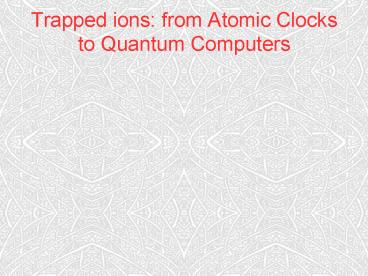Trapped ions: from Atomic Clocks to Quantum Computers - PowerPoint PPT Presentation
1 / 25
Title:
Trapped ions: from Atomic Clocks to Quantum Computers
Description:
Factor numbers in polynomial time! Atomic clocks: What is the point? ... Atomic clock performance. Improves as the length of time between the pulses increases ... – PowerPoint PPT presentation
Number of Views:79
Avg rating:3.0/5.0
Title: Trapped ions: from Atomic Clocks to Quantum Computers
1
Trapped ions from Atomic Clocks to Quantum
Computers
2
Basement
3
Ion Trappers
4
Lab
5
LASER
6
Ion Trap Vacuum Can
7
Ion Trap Electrodes
8
Trapped Ions
9
What can trapped ions be used for?
- Very pure quantum system
- Measurement of atomic properties
- Isolated from the environment
- Atomic clocks with accuracy of 1 part in a
billion billion - Would have lost 0.1s over the lifetime of the
universe - Quantum information processing
- Factor numbers in polynomial time!
10
Atomic clocks What is the point?
- Navigation
- Communication synchronisation
- Measurement
- Tests of fundamental principles
11
What is a clock?
- Oscillator e.g. Pendulum
- Counter e.g. Escapement mechanism
12
How good is a clock?
- Quality of an oscillator is defined as the
frequency of the oscillator divided by the
uncertainty in the frequency of the oscillator - Traditional clocks vary
- difficult to compare clocks
- All atoms of a given isotope are identical
- can compare atomic clocks to each other
13
Quantum Structure of Atoms
- Electrons in an atom can only exist with certain
discrete energies - Transitions between different energy levels have
precise frequencies - Transition energies are blurred due to finite
lifetime of excited states, collisions, ion
motion, magnetic fields, - Superposition states can be created where atoms
are in two states at once (Schrödingers Cat)
14
Quantum Structure of Atoms
15
Fundamental Principles of Atomic Clocks
- Put the ion into ground state
- Illuminate ion with a tunable source operating
near the transition frequency - Detect absorption of the radiation
- Adjust the frequency of the source until it is on
resonance with the ionic transition
16
Frequency
- 1Hz 1 cycle per second - e.g. human pulse
- 10-100Hz - nervous system response time
- 100kHz-10MHz - AM radio
- 100MHz - FM radio
- 1GHz - microwaves
- 100THz-1PHz - IR, visible light, UV
17
Resonance
18
Ions - what oscillates?
- Atomic clocks make use of quantum mechanical
superposition states - The ion is placed in a superposition of two
internal states - The phase between the states oscillates with time
- Measuring the state when the ion is in a
superposition gives a random result
19
Ramsey Interferometry
20
Atomic clock performance
- Improves as the length of time between the pulses
increases - Improves as the frequency of the transition
increases - Limited by the need to be able to count the
cycles of the exciting radiation - Optical clocks are the present state of the art
- Improves as the ions are cooled
- Improves if entangled ions are used
21
Entanglement
22
Quantum Computation
- N two-level ions can span a space of dimension 2N
- Can initialise a N-qubit register and perform
computations on all possible 2N inputs at once - Quantum algorithms have been designed to make use
of entanglement during a computation but still
give a classical result
23
My Research
- Need to be able to read out the internal state of
the ion - Energy levels used in our implementation are
separated by a frequency difference much smaller
than the linewidth of the transitions - Make use of electromagnetically induced
transparency (EIT) to cancel absorption from the
unwanted state
24
Results
25
Conclusion
- Thank you for your attention
- Further details available at http//nodens.physics
.ox.ac.uk/mcdonnell/ALsem/ - Any questions?































